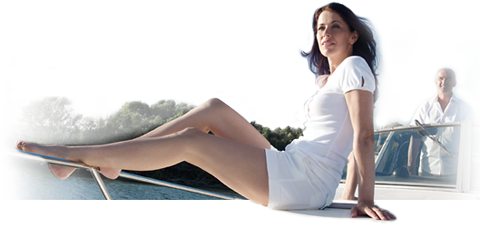Varicose veins are a common disease
Here you will find important studies and guidelines on the topic

Gentle and safe removal of spider veins: Scientists recommend sclerotherapy rather than laser therapy
As the weather starts getting hotter, various blemishes come to light. Can we happily show ourselves in short skirts, shorts and swimwear in spring and summer or do spider veins spoil the appearance of our legs? Although the clearly visible dilated veins can be easily removed nowadays, sufferers are often uncertain about which treatment method would be the best for them. The current guideline of the European Society for Laser Dermatology (ESLD) clearly states that sclerotherapy remains the treatment of choice for spider veins on the legs, as it has proved to be more effective and gentle than laser therapy.
Who would not like to have attractive and healthy legs?
Attractiveness and a well-groomed, youthful appearance are becoming more and more important for people of all ages – and this includes attractive and healthy legs. In reality, however, more than half of all adults in Germany suffer from venous blemishes such as spider veins. The clearly visible bluish-red venous networks on the thighs and lower legs often prevent women from feeling at ease when wearing light summer clothing for sporting activities or on the beach. So it is no wonder that a growing number of sufferers declare war on spider veins.
Modern procedures sclerose or heat altered veins
Nowadays, doctors specialised in venous disorders can use advanced treatment methods to remove spider veins in an outpatient setting. This saves the patients a lot of time and they can start working and resume their daily activities immediately after the sessions. Sclerotherapy is the most commonly used treatment: through a very fine needle, a sclerosant is injected into the affected veins, which then close off and are gradually broken down by the body. Laser therapy is another option for removing spider veins. In this case, high-energy light impulses are transmitted through the skin from outside in the the spider veins, in order to obliterate the affected veins.
Laser involve the risk of heat-related injury
Many people regard laser therapy as the “magic bullet” of high-tech medicine. In the treatment of spider veins, however, even the laser experts from the European Society for Laser Dermatology prefer sclerotherapy for the following reasons: as leg veins lie deep under the skin, are under great pressure and vary in size, they can often be reached more easily with a needle than with a laser beam. If spider veins lie slightly deeper under the surface, the laser beams often do not penetrate the tissue deep enough to reach and destroy the veins.
To reduce the risk of heat-related injury, such as redness, swelling or scarring, the skin must be cooled during the laser treatment, especially as the skin on the legs is very sensitive.
Sclerotherapy is safe, effective and almost painless
In their guidelines, physicians of many different disciplines continue to recommend sclerotherapy as the treatment of choice for spider veins. The essential advantages of this treatment that has been established for 50 years, i.e. its efficacy and tolerability, have been comprehensively confirmed by studies. In addition, sclerotherapy can also occlude veins that cannot be reached by laser beams because the beams cannot penetrate deeply enough. This is especially important for the so called “feeder veins” that supply many of the spider veins with blood and prevent their permanent removal if they are not treated and the blood flow continues.
In study series comparing both procedures, subjects also reported faster cosmetic success with sclerotherapy.
In case of doubt choose sclerotherapy
There is no question about it: laser do have their strengths – for example in treating dilated facial veins. But if attractive, healthy legs are the desired outcome, laser treatment can only be recommended for very small spider veins lying just below the skin or for people who dread injections. Most venous patients are better off with sclerotherapy, as the established method of treatment leads to excellent treatment results and is almost painless and well tolerated. The low costs of sclerotherapy are another convincing argument in its favour – after all, patients usually have to pay for the removal of aesthetically unsightly spider veins out of their own pocket.
Find out more now at www.healthy-veins.com
If you want to start off the coming summer with perfect legs you can find valuable help for making a treatment decision as well as information and tips at the new website www.healthy-veins.com. In addition, using the vein checks developed by Prof. Eberhard Rabe M.D. at www.venen-im-check.de, you can assess your own risk of developing a venous disorder.
